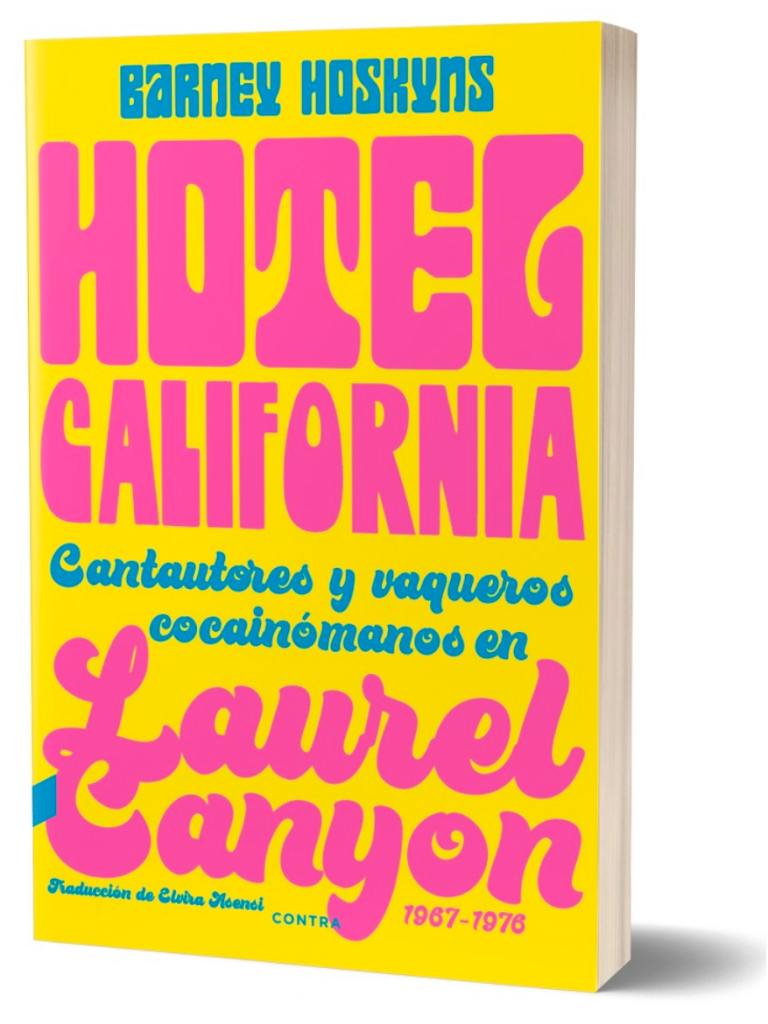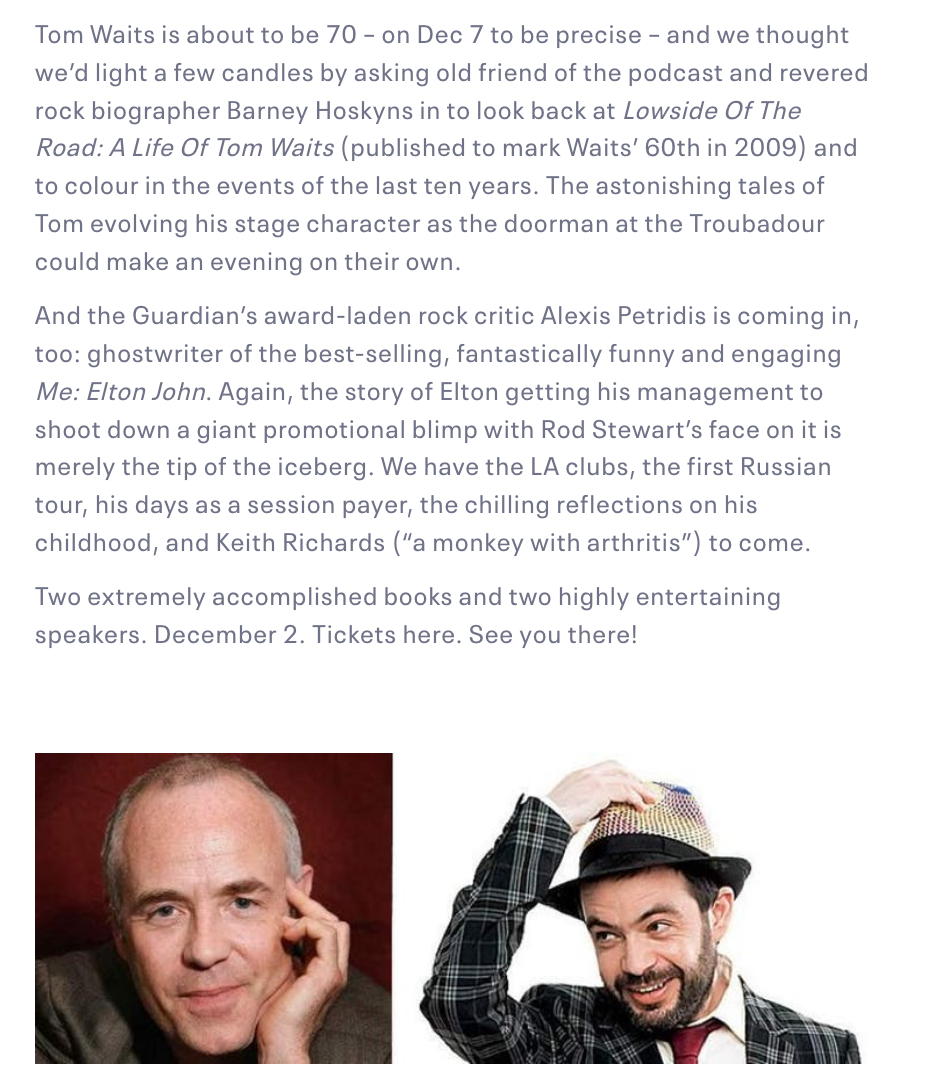
Tom Waits
My All-Time Top 100 Tracks
The great Dave Bates – the guy who signed Teardrop Explodes, Def Leppard, Tears for Fears, Texas & Wet Wet Wet and reinvented the careers of giants like Robert Plant & Scott Walker, then and then resurrected the dormant Fontana label with bands like the House of Love & the Cocteau Twins – invited me to send him a playlist. So I did: the favourite 100 tracks (give or take) I’d stream on my desert island.
You can hear ’em here...

Hotel California en Espanol

Somehow it seems fitting that my Hotel California has finally been translated into Spanish, since California was nicked from Mexico in the first place. My thanks to Didac Aparicio at Contra and to Elvira Asensi for translating it. Feel free to check in anytime…
Hoskyns in the hole: A Tom Waits podcast
Sam & Tom of Down In The Hole asked me to talk (remotely) about Waits. This is the conversation we had on May 14th. It was good fun.
Fave albums 1974-1985

Johnnie Johnstone of New Perfect Collection asked me and a bunch of other folks to list their 30 best albums released between January 1st, 1974 and December 31st, 1985. As resistant as I am to lists (as blokey and reductive), I couldn’t, well, resist. So here in no particular order are my platters of choice… no doubt fairly bloody obvious, but still as honest as I can be:
Todd Rundgren: Todd
Burning Spear: Marcus Garvey
Joni Mitchell: Court & Spark
Television: Marquee Moon
Talking Heads: ‘77
Associates: Sulk
Gene Clark: No Other
Led Zeppelin: Physical Graffiti
Earth, Wind & Fire: I Am
Stevie Wonder: Songs in the Key of Life
Bob Marley & the Wailers: Natty Dread
Ramones: Leave Home
Joy Division: Unknown Pleasures
David Bowie: Low
Al Green: Al Green is Love
Bobby Womack: Lookin’ for a Love Again
Neil Young: Tonight’s the Night
Chic: Risqué
Kate Bush: The Dreaming
Prince: Dirty Mind
Rickie Lee Jones: Pirates
Tom Waits: Swordfishtrombones
Steely Dan: Gaucho
Dennis Wilson: Pacific Ocean Blue
Fleetwood Mac: Tusk
Randy Newman: Good Old Boys
Suicide: Suicide
Elvis Costello: Get Happy!!
Donald Fagen: The Nightfly
Luther Vandross: Any Love
A Waits in your ear: Happy birthday, Tom

Happy 70th birthday to Tom Waits: That’s me in the middle of David Hepworth & Mark Ellen, clutching the paperback of my Waits biog Lowside Of The Road… and about to start the highly enjoyable Word In Your Ear podcast last Monday. Thanks to those major dudes for inviting me… and also for inviting the excellent Alexis Petridis to talk about Elton “Me” John.
A Waits in your ear
Word honchos Mark Ellen & David Hepworth have kindly invited me to talk on their very jolly podcast about Tom in the week of his 70th birthday. So on Monday December 2nd, I’ll be trotting up to north London to wax Waitsian with the two of them… as well as to listen to the evening’s main attraction: chief Guardian pop critic and Elton John’s amanuensis Alexis Petridis. More details here
Elliot Roberts RIP: An interview from 1993

To mark the passing of one of rock’s great managers, here’s a shortish piece I wrote for MOJO in the summer of 1994 – a year after I interviewed Elliot (about Neil, Joni, David Geffen and much more) at his Santa Monica office for my L.A. book Waiting for the Sun. I enjoyed talking to Elliot, and interviewed him again in the noughties for Hotel California and my Tom Waits biog.
FEW OTHER artist/manager relationships have endured as long as the one between Neil Young and Elliot Roberts. It is nearly 30 years since the lanky, shambling singer first knocked on Roberts’s Laurel Canyon door and suggested he manage him as a solo artist. Nor has the former Elliot Rabinowitz forgotten that it was Young, along with his first charge Joni Mitchell, who helped him to establish a decisive foothold in the LA rock community of the early ’70s.
Like David Geffen, his partner in the formidable management company they established in 1970, Roberts was a graduate of the legendary William Morris mailroom in New York. But it was a young Canadian folk singer who proved to be Roberts’s passport out of the Bronx of his boyhood. Living in Greenwich Village, Elliot heard Joni Mitchell singing one night at the Cafe A Go Go and made up his mind there and then to dedicate his life to furthering her career. “I told her I’d kill for her, even though the folk period had died and she was totally against the grain,” he says. “We tried every company in New York, and everyone turned her down.” By 1967 the pair of them were living in the new pop mecca of Los Angeles – “strangers in a strange land”, as Mitchell recalled – and David Crosby was producing her debut album across the hall from Buffalo Springfield at Sunset Sound studios.
Already in disarray at this point, the Springfield were in the process of severing ties with their existing managers Charlie Greene and Brian Stone. It was only a matter of time before they approached Roberts and asked him to help them sort out their differences. When Young stormed out of the preliminary meeting to discuss this, it turned out to be a pretext for his leaving the band and persuading Roberts to manage him solo.
Roberts rapidly found himself at the hub of the coalescing Laurel Canyon scene, consisting of equal parts country-rock bands and confessional singer-songwriters.
“Here I am looking after Neil, and in the meantime I’m making Crosby’s deals, and everyone from Donovan to Mick Jagger is coming down to Joni’s sessions. Then Graham Nash comes to town with the Hollies, so Joni and Steve Stills and I go, and that night we invite Graham back to Joni’s house for this singfest. It was all so fast.” So fast, indeed, that Roberts saw no option but to call his razor-sharp agent pal David Geffen to sort out the various deals which led to the formation of Crosby, Stills & Nash.
One night the two men were driving through Laurel Canyon when Geffen turned to Roberts and said, “Listen, let’s just do this”. It was the start of the Geffen-Roberts empire, one which would take in the formation of the Asylum label and the signing of such hugely successful acts as Jackson Browne, Linda Ronstadt and the Eagles.
“We were very fortunate in that Joni and Neil drew great people to them like a magnet,” Roberts remembers. “They were totally uninterested in fame and money, yet they knew they were great artists, even when they were failing miserably.”
Asylum Records was literally that: an asylum for the ladies and gentlemen of the Canyon, most of them having affairs with each other and writing songs about them. The scene may have been incestuous but it undeniably produced some of the best music of the ’70s.
“Jackson was up the block, Joni was two houses down, Zappa lived on the corner,” says Roberts. “We really did all walk to the Canyon Country Store, smoking a joint together along Lookout Mountain Road.” What no-one could have anticipated was just how big these artists would become. From the Eagles scuffling at the Troubadour club in 1972 to the Eagles selling out vast arenas four years later was nothing short of a quantum jump.
The Geffen-Roberts empire was eventually broken up, with Irving ‘The Poison Dwarf’ Azoff making off with the Eagles and Geffen himself trying his luck in the movie business before launching the even more obscenely successful Geffen label in the early ’80s. Even Joni Mitchell changed management in the ’80s, entrusting her career to James Taylor/Linda Ronstadt producer Peter Asher. Only Neil Young stuck with the man whose taste and vision were so instrumental in shaping the sound of West Coast rock in the ’70s.
“Neil and I still have screaming fights all the time,” says Roberts, whose appearance suggests Woody Allen after 25 years in the warm California sun. “People were always very afraid of Neil, but he was actually very frail. He’s not any more, because he’s been training for years and he’s beefed up to 165 and he’s an axe murderer. But he sort of glared at people and they’d freeze. He was so intense, nothing was casual. But I never think of him as a Lone Wolf, because he’s a good friend and he’s very funny. And he’s very gracious. He likes to fail. He’s had a lot of bad breaks, bad relationships, and they’ve all affected what he does. It’s not like the art is separate from the life, it’s one and the same with Neil. He’s always Neil.”
Faber Social’s Greatest Hits
Chuffed to be in this exalted company. Out Feb 7th…
Tom Waits doc

I consulted on – and was interviewed for – this new Waits doc airing Sunday, but some martinet of a Beeb exec demanded there be “no journos!” in the film. Or even Tom Waits biographers, by implication…
Hey, I’m sure it’ll be great fun.